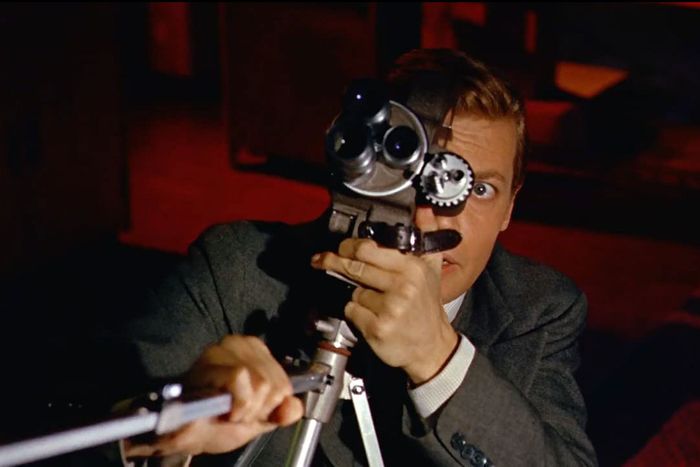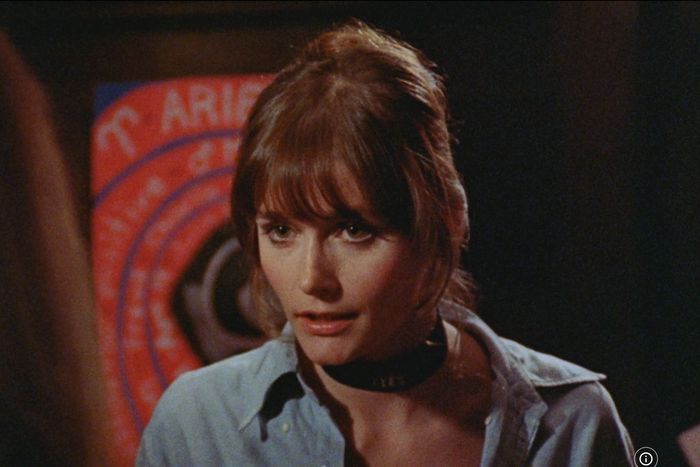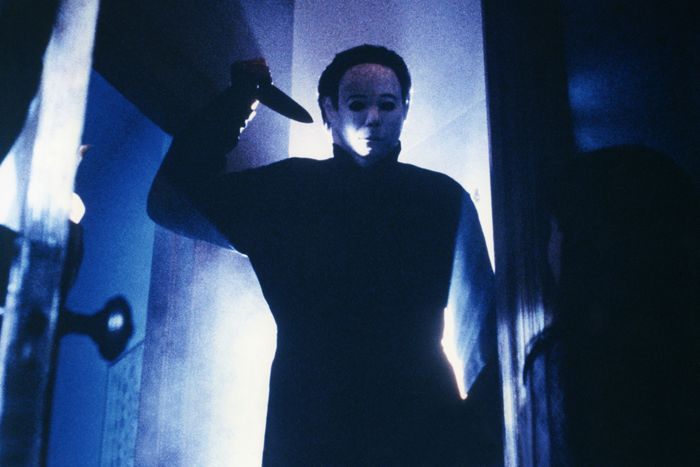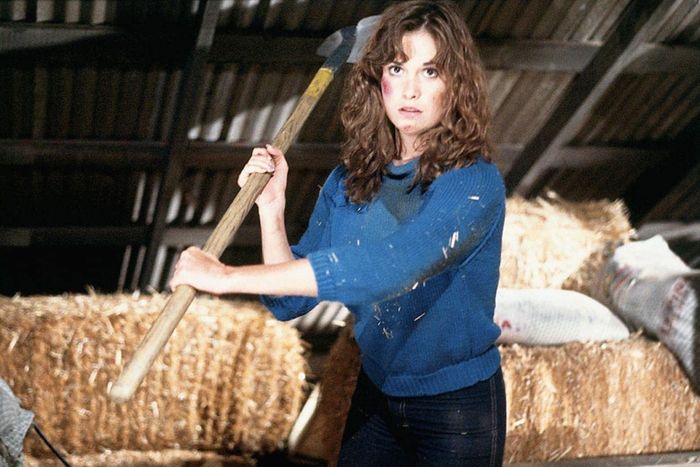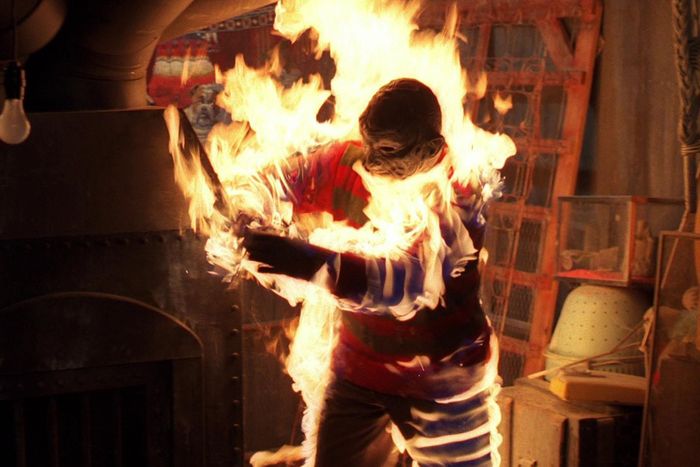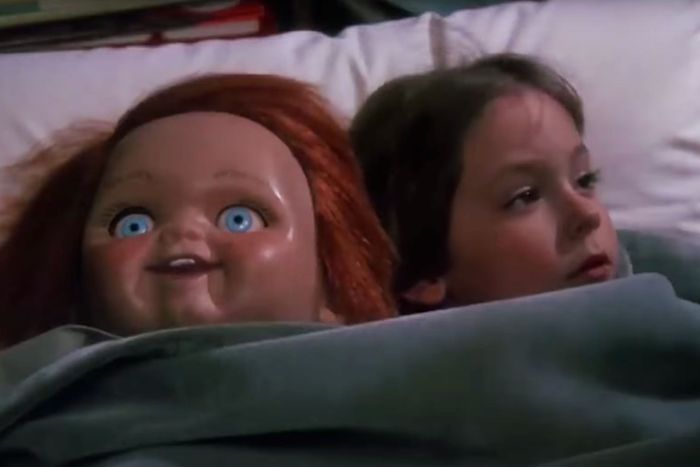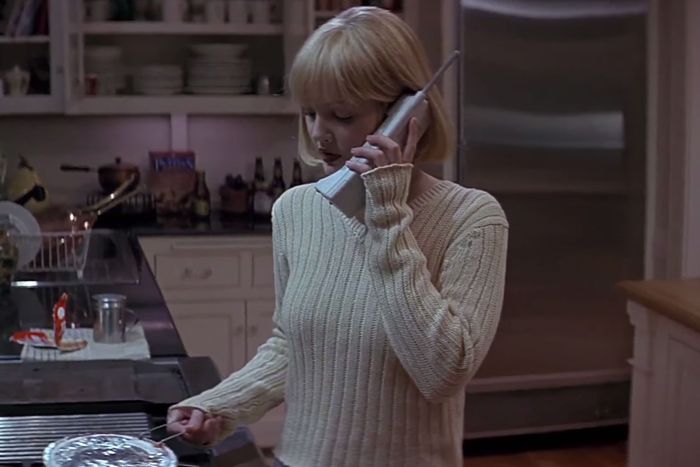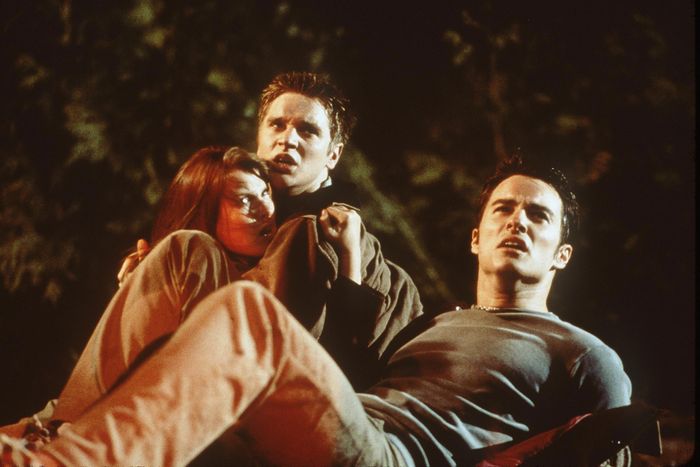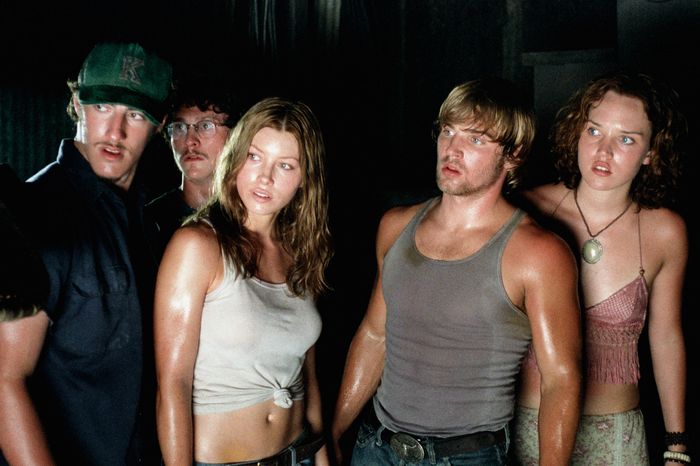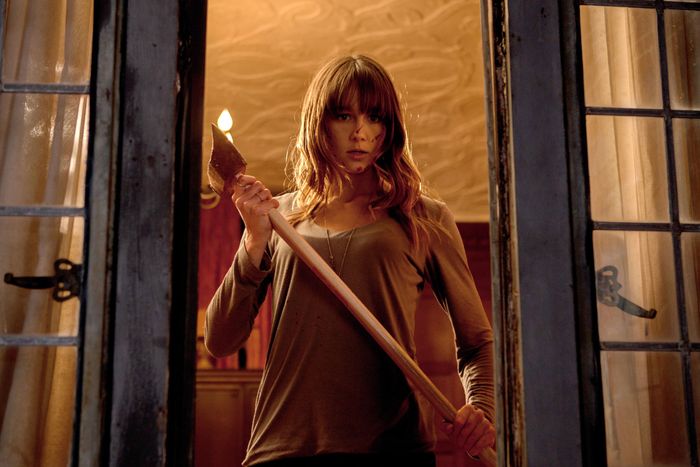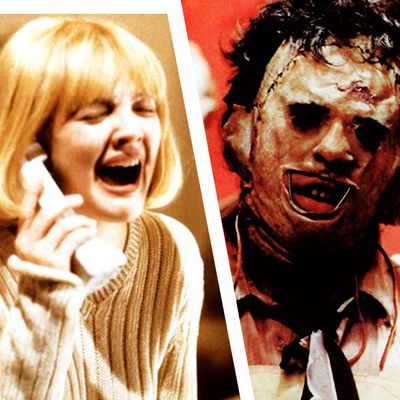
This article originally ran in 2018. We’re republishing it because it’s spooky season.
Sidney Prescott famously summed up in Scream what many think about a certain horror subgenre: “Some stupid killer stalking some big-breasted girl who can’t act, who is always running up the stairs when she should be running out the front door.” She was talking, of course, about the most popular and prevalent of all horror subgenres: the slasher film. Prescott’s definition aside, the slasher is a cinematic mainstay that, like Scream, involves a violent, often masked psychopath who stalks and murders groups of people with bladed weapons. With slashers, you can count on high body counts involving gory death sequences, a killer motivated by a past trauma, and a protagonist that outlasts their friends to face off against the killer and survive, usually in the form of the Final Girl.
The Grand Guignol of horror, the slasher slowly gave rise in the 1960s before exploding in the late ’70s following the massive success of John Carpenter’s Halloween. Dubbed the Golden Age of Slashers, 1978–1984 brought on an onslaught, crowded with copycats that sought to recapture the glory of Carpenter’s instant classic. Though the category may have waned in popularity shortly after, it still remained a horror fixture, reinventing itself time and time again.
Slashers also have a habit of reflecting the current social climate, offering real-life horrors hidden behind the safety of schlock and entertainment. The thrill that comes with facing our fears keeps audiences coming back again and again — as do the 30 influential slashers on this list, which not only helped usher in the genre but continued to evolve it. These are the game changers, the rule breakers, the iconic, and the absolutely terrifying.
Peeping Tom (1960)
The backlash for this British psychological horror film was so strong upon release that director Michael Powell never made another British film again. Revolving around an aspiring filmmaker that uses his camera to murder women while simultaneously capturing their dying expression on film, the violence, sexual content, and voyeuristic themes proved too much for audiences to handle at the time. In the decades since, Peeping Tom not only amassed a cult following, but critical reappraisal that acknowledged the layered psychology of a serial killer. It’s chilling and uncomfortable in its placement of the viewer as an accomplice to the killer’s crimes, and the perspective from the killer’s camera directly influenced the POV element of future slashers to come.
Psycho (1960)
Based on Robert Bloch’s novel of the same name, which itself was loosely inspired by serial killer Ed Gein, Alfred Hitchcock’s Psycho shocked audiences at the theater. Opening with the scandalous scene of Marion Crane (Janet Leigh) during a mid-lunchtime tryst with her lover Sam Loomis (John Gavin), she then steals a massive sum of cash from her employer and decides to flee to California. In route, she winds up at Bates Motel, where one of cinema’s most iconic scenes takes place: Crane is murdered in the shower by the mother of plucky hotel proprietor Norman Bates (Anthony Perkins). Unprecedented for its depictions of violence and sexuality, Psycho also was among the first to render its killer empathetic. The killer’s knife, the first-person perspective, and the unnerving way in which audiences sympathize with Norman Bates all played a major role in the shaping genre, and its DNA is all over eventual slasher staples like Halloween and Scream.
Blood and Black Lace (1964)
A simple murder mystery set in a fashion house in Rome, which sees its models getting brutally picked off one by one by a masked assailant, becomes a thrilling genre exercise thanks to director Mario Bava’s employment of vivid color schemes, lighting, and extravagant set-piece murders. Blood and Black Lace was formative for the Italian giallo, a subgenre of film that refers to stylized murder mysteries that merge thriller elements with horror. Bava shot each death differently, with different color schemes and murder weapons, resulting in a viewing experience that’s both aesthetically lush and very violent, resulting in a notably high body count.
A Bay of Blood (1971)
Also known by its alternate title Twitch of the Death Nerve, the film centers on the murder of a wealthy countess by her own husband, which sets off a string of murders in the surrounding area. Less stylized than Blood and Black Lace, director Mario Bava instead opts to revel in the gory violence of the murders. Though the motive behind the killer (or in this case, killers) are a bit more complicated than the likes of most modern slashers, there are a lot of recognizable hallmarks at play in A Bay of Blood — chiefly, a group of carefree teens who decide to camp in the woods to party and have premarital sex before falling victim to ruthless demises. In fact, many of the death sequences are lifted and replicated in Friday the 13th Part 2.
Torso (1973)
Sergio Martino’s giallo lacks the visual style of his Italian colleagues; really, his nihilistic Torso has a lot more in common with the American slasher. It follows a mysterious masked killer who stalks and butchers female college students. He’s particularly nasty to the promiscuous, and like most slasher antagonists, he has a vendetta against those he feels wronged him for a past misdeed. Being that this is an Italian feature, though, it’s far more sleazy, debauched, and pessimistic than most of the Stateside slashers that would pop up during the genre’s Golden Age.
Black Christmas (1974)
Years before director Bob Clark helmed holiday classic A Christmas Story, he took a much more macabre approach to the holiday with Black Christmas. Based on the urban legend “The Babysitter and the Man Upstairs,” this slasher sees a group of sorority sisters getting stalked and murdered by a stranger over Christmas break. The deceptively simple plot is made more complex by the fully realized characters, led by Jess Bradford (Olivia Hussey); they all come with their own personalities and flaws that aim to elicit sympathy and misdirection. Most chillingly, Black Christmas refuses to giving meaning behind the violent deaths of its characters. Its mark on the slasher genre is unavoidable: Clark’s long-tracking shots would be copied in future titles, including the classic that perhaps most heavily drew inspiration from his film: John Carpenter’s Halloween.
The Texas Chain Saw Massacre (1974)
Delivered from the perspective of Leatherface, Tobe Hooper’s seminal horror title plays out like a home-invasion flick rather than a slasher. After all, it’s the victims who had the audacity to enter Leatherface’s home uninvited before meeting their grisly end. Yet The Texas Chain Saw Massacre was vital in the shaping of modern horror as we know it, and a whole host of now-ubiquitous tropes can be traced back to this film: the lumbering, masked killer; the young group of friends that go poking around where they shouldn’t; and one of the earlier examples of the Final Girl archetype in Marilyn Burns’s Sally Hardesty.
Deep Red (1975)
Mario Bava may have paved the way for the Italian slasher, but director Dario Argento mastered it with Deep Red. The plot follows a pianist who witnesses the death of a psychic through an apartment window, and then teams up with a reporter to solve the crime. It pulls him into a complex mystery involving a serial killer with an affinity for children’s toys and songs. Argento explores childhood trauma and plays with gender norms as the body count piles up, and the director gleefully makes his audience a participant in the killer’s brutal murders thanks to his flair for visuals. The result: a pinnacle of giallo filmmaking.
Alice, Sweet Alice (1976)
Set in the 1960s, Alice, Sweet Alice sees a 9-year-old girl murdered on the day she’s to receive her First Communion, an inciting event that sets off a string of murders. This film, directed by Alfred Sole, breaks multiple taboos, first by killing a young child early on, and then again by having the girl’s 12-year-old sister Alice as the main suspect behind the slayings. It doesn’t help that the killer’s translucent grinning mask and yellow raincoat terrify with their mix of menace and innocence. Alice, Sweet Alice plays a psychological game of whether or not Alice really is the one behind her sister’s death, and offers up some truly spooky stalker sequences.
The Town That Dreaded Sundown (1976)
Set in 1946, this proto-slasher takes a true-crime, docu-thriller approach to the masked killer on the loose in the small town of Texarkana. Taking the “based on a true story” concept from The Texas Chain Saw Massacre and evolving it into something new, the film spins the Phantom Killer case into a fictional horror with haunting atmosphere and disturbed masked killer. The police-procedural aspect enhances the grim nature of the stalk-and-slash murders, and the strange weapon choices (like the infamous trombone) really elevate the creep factor. While the film may not be as well-known as some of the others on this list, it certainly had a direct influence on later titles like Scream and even earned a sequel of the same name in 2014.
Halloween (1978)
What’s left to say about this classic that hasn’t already been said? The quintessential slasher film launched the genre’s Golden Age and inspired countless copycats in the wake of its release. The movie’s hallmarks are many, particularly its high body count, elaborate stalk sequences, and the horrific way in which Michael Myers admired his work. John Carpenter eschewed overt violence and gory kills in favor of simplicity and heavily stylized suspense, and his silent killer’s unrelenting pursuit of innocent babysitter Laurie Strode (Jamie Lee Curtis) is a masterclass in tension-building. Simply put, Halloween is the definitive poster child of the slasher film.
Friday the 13th (1980)
Bloody, shocking, and with a final cliffhanger jump scare, it’s no wonder this turned into one of horror’s most enduring and successful franchises of all time. The film centers on a group of camp counselors working to reopen a summer camp years after a child’s drowning. Their work is thwarted, though, when they begin getting picked off one by one by an unseen foe. Though Friday the 13th draws heavily from slashers that came before it, it does firm up established rules that would later become commonplace — particularly, that premarital sex equals a vicious demise. The killer’s identity reveal was a fun icing-on-top twist, further solidifying Friday the 13th’s place in the pantheon of slashers.
Maniac (1980)
Director William Lustig’s Maniac bucks the typical formula. Lustig presents his slasher, told entirely from the perspective of Frank Zito (Joe Spinell), a killer with a penchant for scalping women and conversing with his mannequins, from a gritty, psychological perspective. Zito still stalks and kills his prey in gruesome fashion, and this slasher does have a Final Girl in Anna (Caroline Munro). But Lustig and Spinell get uncomfortably intimate with the killer’s spiraling madness and deep-seated mommy issues, and the guerilla-style filmmaking further propels this into exploitation cinema. Maniac was a serious rule breaker, and all the more memorable for it.
The Burning (1981)
Released in close proximity to Friday the 13th and with a similar plot setup (camp attendees dying at the hands of someone whose trauma stems from previous campers’ carelessness), The Burning isn’t as well-known as its counterpart. Yet it does outshine Friday the 13th in terms of gore alone, with an epic, taboo-breaking finale featuring an insanely high body count. The Burning also boasts special effects by makeup artist Tom Savini, and a memorably creepy killer in Cropsy, a former camp caretaker who’d been set on fire by campers and permanently disfigured as a result. His backstory and look share a lot in common with a certain Wes Craven–created killer that would arrive in theaters just a few years later.
Friday the 13th Part III (1982)
Whereas the first film in this popular franchise revealed Mrs. Voorhees as the surprising killer, and Part 2 introduced her son as the killer out for revenge for his mother’s death, it was this sequel that established horror icon Jason Voorhees as fans recognize him today: The lumbering killer finally picks up that recognizable hockey mask. Granted, Jason’s lingering mommy issues fell to the wayside as he instead slipped into a familiar formula, slaughtering basically any teen who ventured into his home turf of Camp Crystal Lake. While Friday the 13th arguably has more enjoyable sequels, Part III is the one that permanently embedded Jason Voorhees into pop culture iconography.
The House on Sorority Row (1982)
While The House on Sorority Row borrows obvious cues from Black Christmas, from the sorority setting to the morally flawed characters, this slasher also borrows from Alfred Hitchcock and French film Les Diaboliques. When strict house mother Mrs. Slater thwarts plans of the sorority sisters’ graduation party, they rebel by plotting a vicious prank against her. It goes awry, resulting in Mrs. Slater’s death, and the girls opt to hide her body until their party is over. At the party’s peak, Slater’s body goes missing and someone begins picking off the girls one by one. Though the film closely follows the slasher rule book, it also dares to make its lead protagonists warrant the vicious revenge coming their way. Popular ’90s slasher I Know What You Did Last Summer likely drew inspiration from this morality-based horror film.
The Slumber Party Massacre (1982)
Directed and produced by Amy Holden Jones, and written by Rita Mae Brown, The Slumber Party Massacre appears to be just another generic horror flick at first glance. The simple plot follows a, yes, slumber party gone wrong when a power-tool-wielding maniac crashes the party and picks off the girls one by one. Beneath the surface, though, is a clever twist to the Final Girl trope and a feminist slant that brought a refreshing take during the peak of oft-misogynist slasher copycats. Inspiring two more sequels, The Slumber Party Massacre films also happen to be the only series in the genre directed exclusively by women.
Sleepaway Camp (1983)
Another camp-set slasher that follows tried-and-true patterns, Sleepaway Camp has amassed a major cult following through the decades since its release. The premise: Shy Angela Baker’s arrival at camp marks the beginning of a series of deaths to anyone that dares to mess with her. The deaths are over-the-top and nasty, but there’s a tinge of comedy to the whole thing that sets this one apart from similar horror films released in the same period. It also stands out for its unusual examination of gender roles, building up to one of horror’s most shocking final shots of all time. If you’ve seen it, you’ll never forget it.
A Nightmare on Elm Street (1984)
Just as the slasher craze was dying down, Wes Craven’s A Nightmare on Elm Street promptly revived interest thanks to the introduction a key new element: the supernatural. Playing with the concept that people are at their most vulnerable while sleeping, Craven created a horror icon with Freddy Krueger (played with gusto by Robert Englund), an evil entity seeking revenge for his murder by slaying the children of his killers in their dreams. Great special makeup effects, a terrifying villain, and one of horror’s most cherished Final Girls in Nancy Thompson (Heather Langenkamp) all helped to launch one of horror’s most successful franchises of all time.
April Fool’s Day (1986)
It’s difficult to discuss what it is about April Fool’s Day that makes it an important contribution to the genre without giving away the twist that makes it stand out. On paper, it’s a familiar and formulaic slasher that sees a group of friends falling victim to a killer at a remote mansion over April Fools’ weekend. There’s less gore than usual, and the deaths aren’t even the most inventive. But it does have Deborah Foreman (Valley Girl) relishing her bad-girl role, which is a big plus, and once the film reaches the third act, everything we thought we knew about the slasher is undone with an unexpected narrative detour. Not only did this one get remade in 2008, but it proved that even a seemingly formulaic format could still offer big surprises.
A Nightmare on Elm Street 3: Dream Warriors (1987)
Long before writing and helming the Stephen King adaptations Shawshank Redemption and The Mist, Frank Darabont co-wrote one of the best slasher sequels of all time with director Chuck Russell. A Nightmare on Elm Street 3: Dream Warriors not only brought original hero Nancy Thompson back to usher in a new generation of Elm Street kids and square off against Freddy Krueger one more time, but this follow-up’s deep dive into the surreal dreamscape altered the course of the franchise permanently. Under Nancy’s guidance, this new group of would-be victims learn to fight back in their dreams with unique dream abilities, imbuing a sense of empowerment and fun to what had previously been a very serious series. A showcase of practical effects, Freddy’s kills are among the most inventive around. More importantly, this sequel signaled that it was okay for the central antagonist to have a personality.
Child’s Play (1988)
Child’s Play marked the birth of a new icon: serial killer Chucky (Brad Dourif). Only, this serial killer was forced to possess a Good Guy Doll by way of voodoo after an intense shootout opening scene. That doll ends up in the hands of a 6-year-old, and Chucky’s murder spree is marked by his motivation to find his way back to a human body. Borrowing a page from Freddy Krueger, this antagonist is known for his short temper and humorous quips, but Child’s Play changes the mold by making its Final Girl a 6-year-old boy and updating the traditionally suburban or rural setting in favor of urban Chicago.
Candyman (1992)
Written and directed by Bernard Rose, and based on a story by Clive Barker, Candyman injects gothic romance into the slasher. Graduate student Helen Lyle (Virginia Madsen) summons the urban legend boogeyman known as Candyman (Tony Todd) into existence, unleashing a torrent of pain and death against the backdrop of urban decay in a Chicago housing project. Rose deconstructs the slasher formula and rebuilds it around themes of race, privilege, and taboo relationships. On top of that, Madsen’s Helen is atypical of the traditional Final Girl, falling under the mesmerizing spell of Candyman — as do we.
Scream (1996)
By this point in the ’90s, the slasher craze had all but died. It was revived anew, with a bigger bloodlust than before, thanks to this entry to the canon from writer Kevin Williamson and director Wes Craven. Scream approached genre conventions with a meta-awareness and used it to consistently subvert audience expectations. The story not only gave the characters a full understanding of horror films and its tropes, but also used the audience’s working knowledge of slasher films against them from the outset. No one expected the most well-known actor of the entire cast, Drew Barrymore, to be dispatched so viscerally in the opening scene, and the narrative only continued to defy expectations from that point onward. Craven proved yet again that horror always has new ground to explore. Scream ushered in a wave of ’90s teen horror, and inspired countless meta-approaches to the genre since.
Halloween H20: 20 Years Later (1998)
Released in the middle of the aforementioned teen-horror cycle of the ’90s, Halloween H20 ignores all sequels post–Halloween II to revive the franchise’s central conflict, the deep-seated grudge match between Laurie Strode and Michael Myers. Set 20 years after the events at Haddonfield Memorial Hospital, Laurie Strode went into hiding and rebuilt a new life for herself under a new identity. Now a dean at a private boarding school with a son, Michael finds her to finish what he started. This sequel also had deeper goals as it attempted to explore the effects of trauma on a Final Girl, a relatively novel concept that served as the basis for 2018’s Halloween.
Final Destination (2000)
This franchise-spawning supernatural entry followed a group of teens who escape a gruesome tragedy, only to find themselves stalked and elaborately murdered in the order of which the original tragedy would have claimed them. It checks off every slasher trope on the checklist, from the character archetypes, tension-filled death scenes, and a seemingly unstoppable killer. The only difference? This killer is Death itself, an unseen force that looms large over the entire film. By having a killer without any tangible presence, Final Destination introduced an intriguing twist to an old format.
High Tension (2003)
Known as Haute Tension in native France, this breakout hit by director and co-writer Alexandre Aja ushered in a movement of brutal French horror referred to as New French Extremity, known for its savage depiction of violence. The aptly titled High Tension delivers just that as it follows friends Marie (Cecile de France) and Alex (Maïwenn) during their weekend stay with Alex’s family at their secluded farmhouse. When an intruder slaughters Alex’s family before running off into the night with her, Marie sets off to retrieve her friend. With an intense chase littered with victims, Aja brought a new take on the cat-and-mouse, stalk-and-murder format — as well as a twist ending that polarized audiences.
The Texas Chainsaw Massacre (2003)
A stylized, polished remake of Tobe Hooper’s classic upped the ante on gore and brutality, and it became a sleeper hit upon release in 2003. The plot makes some major changes to the narrative journey, but the basic setup remains the same: A group of five friends find themselves stalked by Leatherface and his twisted family after picking up a hitchhiker. Though a slicker update of one of horror’s most influential films, this remake didn’t just kick-start a new series of Chainsaw Massacre films but an entire wave of slasher remakes in the early aughts, from Black Christmas to Halloween.
Behind the Mask: The Rise of Leslie Vernon (2006)
This meta-slasher takes a black-comedy approach as it follows an erstwhile serial killer looking to enter the ranks of Freddy Krueger and Jason Voorhees as he plots his big night of murder. He even invites a film crew to document his rise, walking them through his plans as he selects his Final Girl and prepares for a night of carnage. Director and co-writer Scott Glosserman pays loving homage to the genre with cameos and a dissection of cherished tropes and archetypes. While none of that is necessarily groundbreaking, Glosserman takes his film a step further by also taking aim at the found-footage subgenre.
You’re Next (2011)
A family gathering at a remote house in the woods turns nightmarish when a trio of masked killers shows up during dinner. Written by Simon Barrett and directed by Adam Wingard, You’re Next lulls the viewer into the false expectation that the film will play out as a standard entry in the home-invasion realm. It doesn’t take long after the bodies begin to pile up that Wingard and Barrett pulls the rug out from under you — You’re Next is actually a slasher in disguise. The masked killers may be stalking and slaying the Davison family members one by one, but they’ve met their match in Final Girl Erin (Sharni Vinson), a woman with a secret talent for survival. Clever, subversive, and imbued with a wicked sense of humor, this film gives its survivor girl strength from the outset while toying with the very definition of a slasher.


